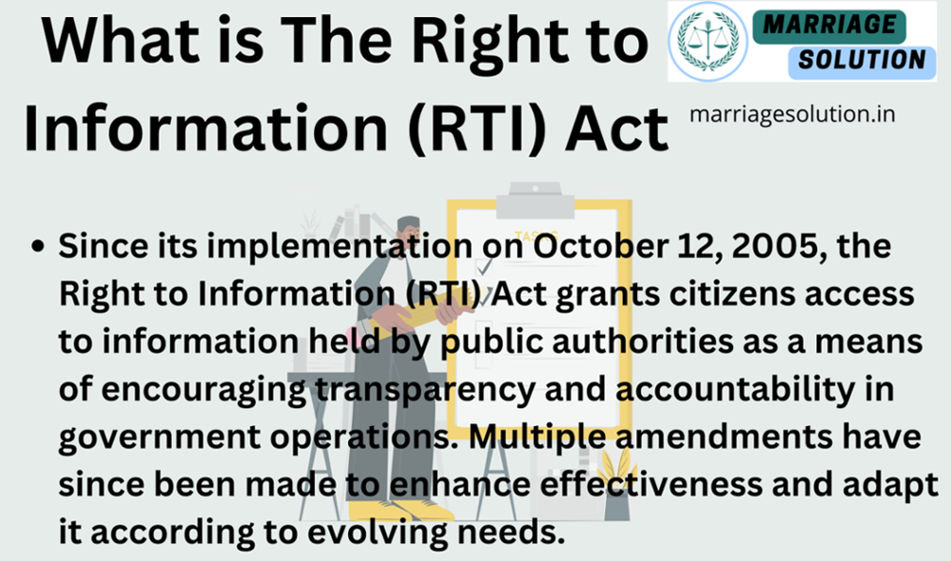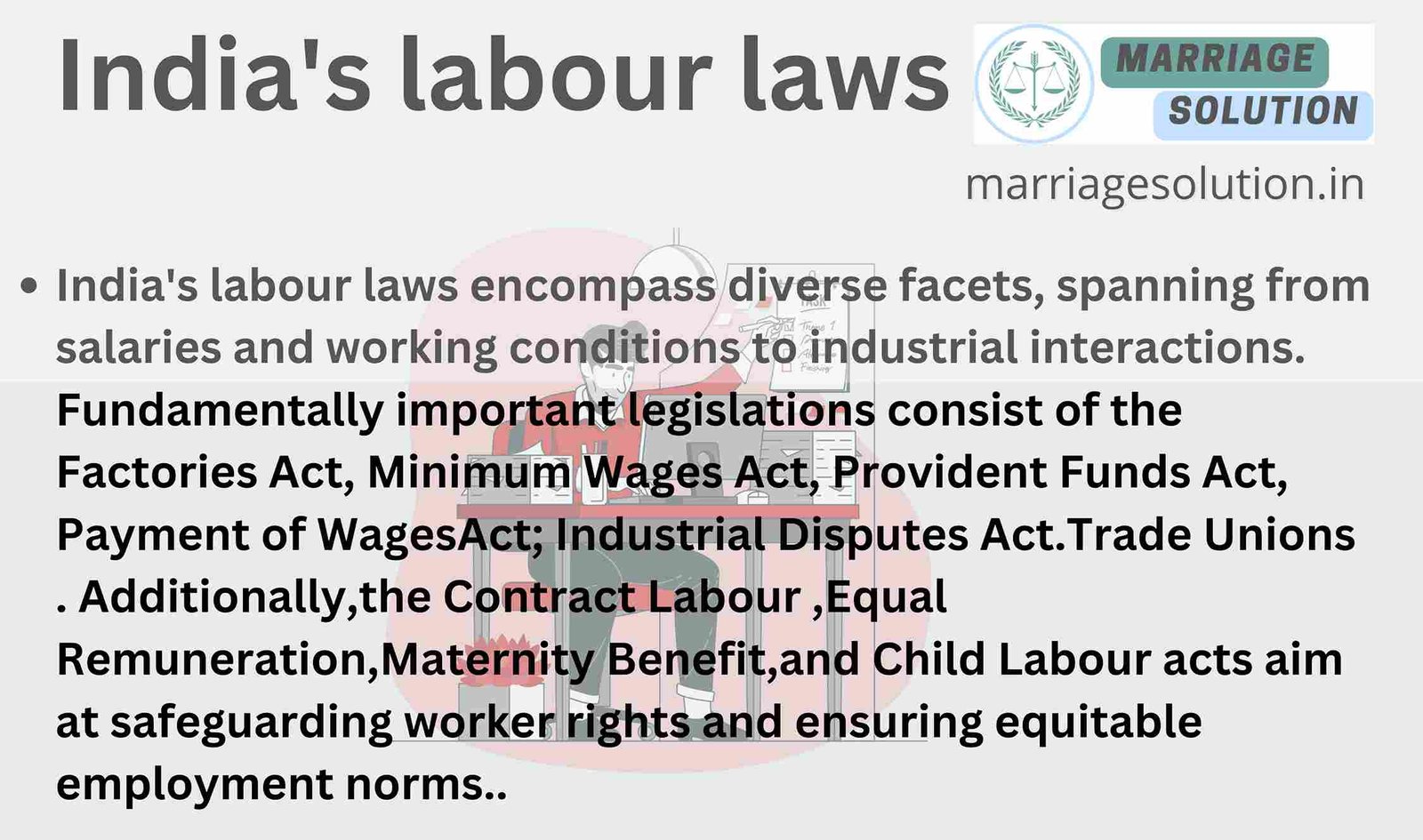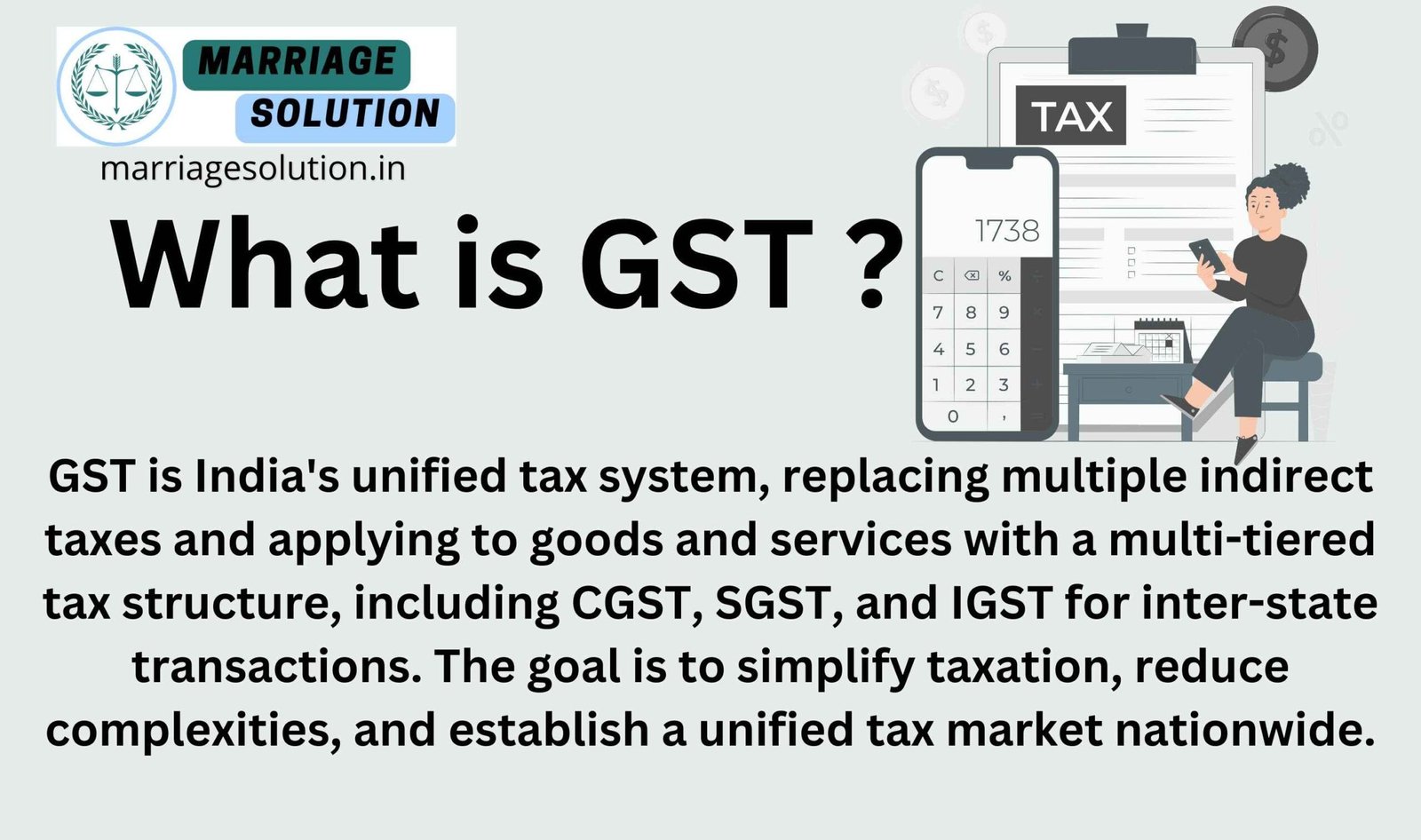Introduction of IPC 144
Indian Penal Code (IPC) Section 144 deals with people who are part of an unlawful assembly while carrying deadly weapons. If five or more people gather with the intent to commit a crime or disturb public peace, and if anyone in the group has a weapon capable of causing death or serious injury, they can be punished under this section.
- Introduction of IPC 144
- What is IPC Section 144 ?
- Section 144 IPC in Simple Points
- IPC Section 144 Overview
- 2. Definition of Deadly Weapons
- 3. Increased Punishment Due to Weapons
- 4. Presence and Knowledge Matter
- 5. Role of the Magistrate in Dispersing Assemblies
- 6. Prevention of Large-Scale Violence
- 7. Emergency Situations and Immediate Effect
- 8. Protection of Public and Private Property
- 9. Exceptions and Lawful Gatherings
- 10. IPC 144 in Modern Use
- Examples of IPC 144 Cases
- IPC 144 Punishment
- 144 IPC bailable or not ?
- Section 144 IPC in short information
- 144 IPC FAQs
- If you need support with court proceedings or any other legal matters, don’t hesitate to reach out for assistance.
What is IPC Section 144 ?
IPC Section 144 of the Indian Penal Code (IPC) states that any person who is part of an unlawful assembly while carrying a deadly weapon, or any object that can be used as a weapon to cause death, shall be punished with imprisonment for up to two years, or with a fine, or both.
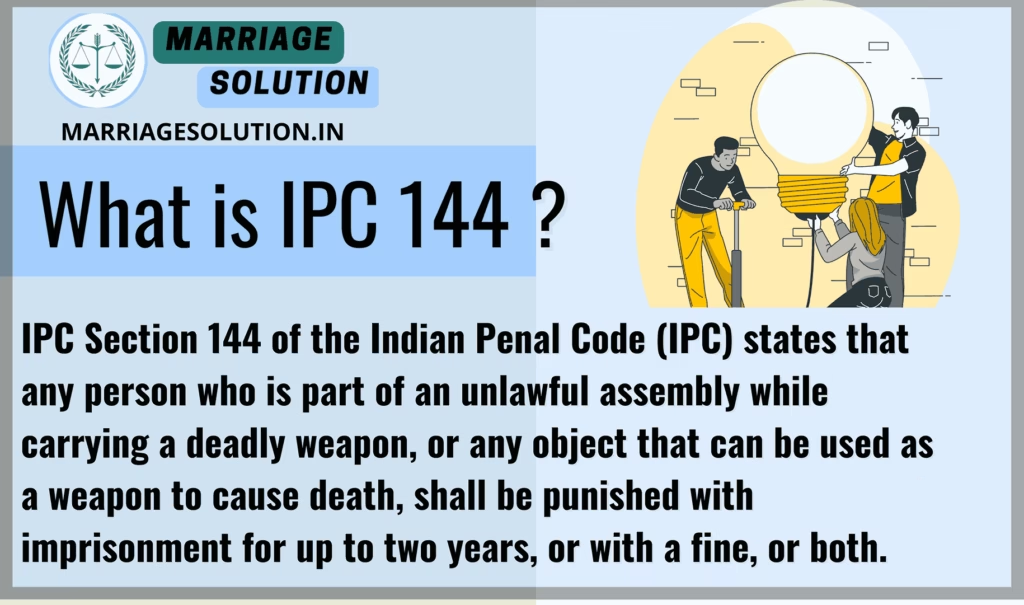
Section 144 IPC in Simple Points
1. Only Applies to Armed Individuals in an Unlawful Assembly
IPC 144 is not for every unlawful gathering—it only applies when someone in the group is carrying a deadly weapon. An unlawful assembly, as defined in IPC 141, is when five or more people gather with a common purpose to commit an illegal act. But if a person in that group has a weapon like a gun, sword, knife, or iron rod, the situation becomes more serious.
For example, imagine a protest where people are shouting slogans—this may not be unlawful. But if some protesters bring weapons like sticks, knives, or petrol bombs, it becomes a threat to public safety. That is when IPC 144 applies. It helps the police take immediate action before violence erupts.
2. The Presence of Weapons Increases the Punishment
Under IPC 143, just being part of an unlawful assembly can lead to six months of imprisonment or a fine. However, when someone in the group carries a deadly weapon, IPC 144 applies, and the punishment increases to two years of imprisonment, a fine, or both.
The reason behind this stricter punishment is that weapons make unlawful assemblies far more dangerous. When people carry weapons in a protest, riot, or mob, the chances of injury, destruction, and loss of life increase significantly. IPC 144 acts as a strong deterrent, discouraging people from bringing weapons into unlawful gatherings.
3. Intent and Knowledge are Important Factors
A person can only be punished under IPC 144 if they knowingly take part in an unlawful assembly where someone is carrying a deadly weapon. If a person accidentally joins a gathering without knowing its illegal purpose, they cannot be punished under this section.
For example, if a man is walking in a market and suddenly finds himself in the middle of a violent protest, he cannot be charged under IPC 144 unless he actively participates and remains in the group. But if someone knows that the gathering is illegal and chooses to stay, especially while carrying a weapon, they will be punished under IPC 144.
4. Helps in Controlling Riots and Violence
IPC 144 plays a major role in controlling riots, political violence, and communal clashes. Many riots start small but become deadly when people bring weapons. This law helps in preventing situations from escalating.
For example, during an election, two rival political groups might clash in a street fight. If some people start carrying weapons like swords or guns, the situation becomes highly dangerous. IPC 144 allows the police to take quick action, arrest the armed individuals, and prevent further violence. This law is particularly important in sensitive areas where communal or political tensions are high.
5. Police and Magistrates Have the Power to Enforce It
The police and the District Magistrate have the authority to enforce IPC 144 by dispersing an armed unlawful assembly. They can issue an order for the crowd to leave. If people do not follow the order, they can be arrested and punished under IPC 144.
For example, if an armed mob gathers near a religious site or government building, the authorities can immediately intervene. The law gives the police the legal power to take action before the situation turns violent. This ensures that public safety is maintained, and law and order are not disturbed.
IPC Section 144 Overview
IPC 144 is a strict but necessary law that helps prevent violent riots, protect citizens, and maintain peace. It specifically targets armed individuals in unlawful gatherings because their presence increases the danger to public safety. Understanding IPC 144 helps people know their rights and responsibilities, ensuring that law and order are maintained in society.
Key-Points
1. Connection to Unlawful Assembly
- IPC 144 is directly linked to IPC 141 (Unlawful Assembly) and IPC 143 (Punishment for Unlawful Assembly).
- IPC 141 defines an unlawful assembly as a group of five or more people gathered with the intention of committing an illegal act.
- IPC 143 states that anyone who is a member of such an unlawful assembly can be punished.
- IPC 144 goes a step further—it applies when a person in the unlawful assembly carries deadly weapons.
- This increases the seriousness of the offense, as armed individuals in a crowd increase the risk of violence and chaos.
2. Definition of Deadly Weapons
- IPC 144 specifically applies when a person is carrying a deadly weapon.
- A deadly weapon is any object that can cause death or serious injury.
- Examples include guns, knives, swords, iron rods, acid bottles, bricks, and stones if used aggressively.
- Even if the person does not use the weapon, just carrying it in an unlawful assembly is enough to attract punishment.
- This provision helps in preventing riots and ensures that violence does not escalate in large gatherings.
3. Increased Punishment Due to Weapons
- Ordinary unlawful assembly (IPC 143) has a lesser punishment—only six months of imprisonment or a fine.
- However, if a person carries a weapon in such a gathering, IPC 144 applies, increasing the punishment.
- The punishment under IPC 144 is up to two years of imprisonment, a fine, or both.
- This harsher punishment acts as a deterrent so that people do not bring weapons to unlawful assemblies.
- The law ensures that potential violence is stopped before it turns into a major incident.
4. Presence and Knowledge Matter
- To be punished under IPC 144, the person must be aware that they are part of an unlawful assembly.
- If someone unknowingly walks into such a gathering, they cannot be punished.
- However, if they stay after realizing the assembly is unlawful, they become responsible.
- This ensures that only guilty individuals are punished and innocent bystanders are not falsely accused.
5. Role of the Magistrate in Dispersing Assemblies
- A District Magistrate or Police Officer can issue an order under IPC 144 to disperse an unlawful assembly.
- This is similar to a referee stopping a violent match before things get out of control.
- If people ignore the order to leave, they can be arrested and charged under IPC 144.
- This provision helps law enforcement maintain order and prevent violent situations.
6. Prevention of Large-Scale Violence
- IPC 144 is used as a preventive law to stop riots, mob violence, and large-scale destruction.
- History shows that many riots and violent protests begin when people in a crowd carry weapons.
- By making it illegal to carry weapons in an unlawful gathering, the law stops violence before it starts.
- It reduces the chances of injuries, loss of life, and damage to property.
7. Emergency Situations and Immediate Effect
- Orders under IPC 144 take immediate effect.
- If a magistrate issues an order to disperse a violent crowd, people must leave immediately.
- Unlike some laws that provide time for compliance, this law requires instant action.
- This is crucial for dealing with riots, violent protests, and sudden outbreaks of violence.
8. Protection of Public and Private Property
- Armed unlawful assemblies often lead to destruction of shops, public transport, religious places, and government buildings.
- IPC 144 helps prevent such destruction by stopping armed groups from gathering in public places.
- This law protects both citizens and businesses from financial and physical harm.
9. Exceptions and Lawful Gatherings
- Not all gatherings are unlawful. Peaceful protests, religious meetings, and community gatherings are allowed.
- IPC 144 is only applied when there is a clear risk of violence.
- Authorities must prove that the gathering is unlawful before taking action.
- This ensures that citizens’ rights to assemble and protest peacefully are protected.
10. IPC 144 in Modern Use
Governments frequently use IPC 144 to maintain law and order.
- It is applied in political protests, religious tensions, communal riots, and public emergencies.
- For example, during violent protests, the government may impose Section 144 of CrPC, restricting gatherings of more than five people.
- This law is an important tool for maintaining peace in society and preventing chaos.
Examples of IPC 144 Cases
Example 1: Riot During a Political Rally
- A political party organizes a rally, but some members carry sticks and iron rods.
- The rally turns violent, and some people attack the police.
- The police order the crowd to disperse, but several people refuse to leave.
- Those carrying weapons are charged under IPC 144 for being armed members of an unlawful assembly.
Example 2: Religious Procession Turns Violent
Those who stay and carry weapons are arrested and punished under IPC 144.
A religious group marches through a city, but some members carry swords and daggers.
A fight breaks out between two religious groups, leading to injuries.
The police impose IPC 144 and order people to leave.
144 IPC Punishment
Imprisonment: If you’re found guilty under IPC 144, you could face up to two years in prison.
Fine: Along with or instead of jail time, the court can also impose a fine.
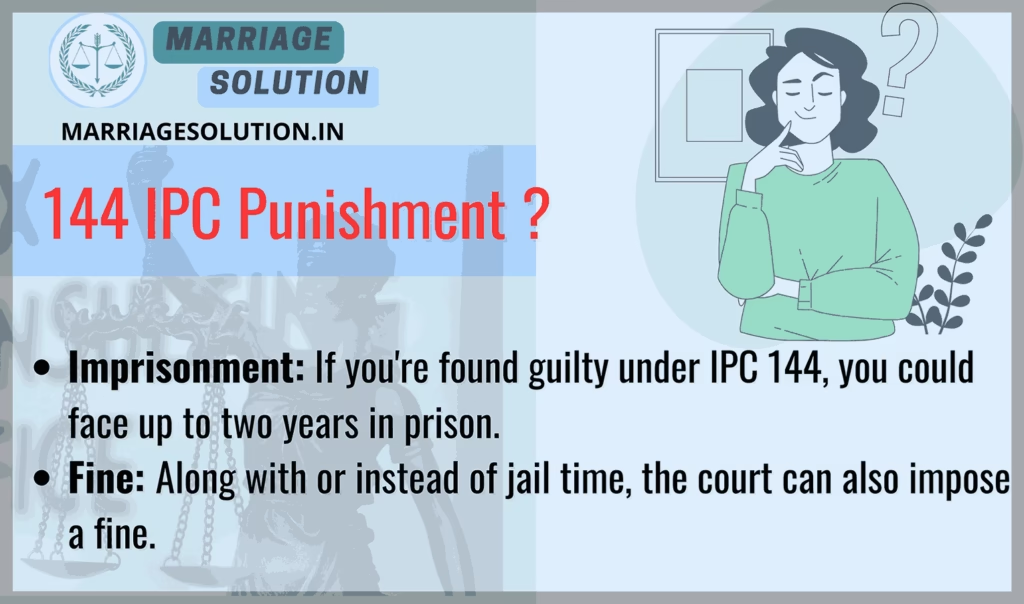
144 IPC bailable or not ?
IPC 144 is generally a bailable offense. This means if you’re arrested under this section, you have the right to be released on bail. You can apply for bail at the police station or court. However, if the unlawful assembly led to more serious crimes, those additional charges might not be bailable.
Section 144 IPC case laws
1. Chunnilal v. State of Uttar Pradesh (1959)
Case Overview:
In this case, a group of 10 armed men gathered near a village in Uttar Pradesh to protest against a land dispute. They were carrying swords and sticks and refused to disperse when the police ordered them to leave.
Court’s Decision:
The Allahabad High Court ruled that since the group was armed with deadly weapons, they could be charged under IPC 144. The court stated that even if only a few members were armed, the entire group would be liable under this section.
Result & Impact:
This case clarified that even if one or two people in a group are carrying weapons, the entire assembly can be punished under IPC 144. It set an important precedent for handling armed protests and unlawful gatherings.
2. Kedar Nath Singh v. State of Bihar (1962)
Case Overview:
During a political protest in Bihar, a group of people gathered and carried hockey sticks, rods, and knives. They were raising slogans against the government and refused to disperse even after repeated warnings from the police.
Court’s Decision:
The Supreme Court of India ruled that since the protestors were armed and refused to disperse, IPC 144 was correctly applied. However, the court also said that this law should not be misused to suppress peaceful protests.
Result & Impact:
This case is important because it highlighted the difference between peaceful protests and unlawful armed gatherings. It established that IPC 144 should be used carefully to balance public order with the right to protest.
3. Madhu Limaye v. Sub-Divisional Magistrate (1970)
Case Overview:
A group of political activists in Maharashtra held a rally where some members carried lathis (wooden sticks). The police imposed Section 144 CrPC (prohibitory orders) and arrested them under IPC 144 for refusing to disperse.
Court’s Decision:
The Supreme Court ruled that Section 144 should not be misused to suppress people’s rights. However, in this case, since some members carried weapons and the situation could have led to violence, the charges under IPC 144 were justified.
Result & Impact:
This case clarified that Section 144 should be applied only when there is a real threat of violence. It ensured that the law is not misused to curb free speech and peaceful protests.
4. State of Karnataka v. Dravida Munnetra Kazhagam (DMK) Workers (1995)
Case Overview:
DMK party workers in Karnataka held a massive rally to protest against government policies. Some supporters carried iron rods and knives, and the police arrested them under IPC 144.
Court’s Decision:
The Karnataka High Court ruled that carrying weapons in a protest makes it a potential threat to public safety. The court upheld the arrests under IPC 144 but warned that peaceful protestors should not be harassed.
Result & Impact:
This case reinforced that political rallies must remain non-violent and that carrying weapons can turn a lawful assembly into an unlawful one under IPC 144.
5. Mohammed Arif v. State of Maharashtra (2010)
Case Overview:
In this case, a religious procession in Mumbai turned violent when some participants started carrying swords and sharp weapons. The police ordered the crowd to disperse, but they refused. The situation led to clashes with another community.
Court’s Decision:
The Bombay High Court upheld the charges under IPC 144, stating that the presence of weapons in public gatherings can cause communal violence. The court ruled that preventing such armed processions is necessary to maintain peace.
Result & Impact:
This case highlighted that Section 144 is important for preventing communal violence and riots. It also established that authorities must take action before the situation becomes uncontrollable.
Section 144 IPC in short information
| IPC Section | Offense | Punishment | Bailable/Non-Bailable | Cognizable/Non-Cognizable | Trial By |
|---|---|---|---|---|---|
| IPC 144 | Joining an unlawful assembly while being armed with a deadly weapon or anything that can be used as a weapon to cause death | Imprisonment up to 2 years, or fine, or both | Bailable | Cognizable | Magistrate |
144 IPC FAQs
What is IPC Section 144?
IPC Section 144 prohibits people from being part of an unlawful assembly if they are armed with deadly weapons or objects that can cause death. It aims to prevent violence and maintain public order.
What is the punishment under IPC 144?
The punishment under IPC 144 is imprisonment up to 2 years, or a fine, or both. The exact punishment depends on the severity of the situation and the court’s decision.
Is IPC 144 a bailable offense?
Yes, IPC 144 is a bailable offense. This means that if someone is arrested under this section, they can apply for bail and be released from custody.
Is IPC 144 a cognizable offense?
Yes, IPC 144 is a cognizable offense. This means that the police can arrest the accused without a warrant and begin an investigation without prior approval from the court.
How is IPC 144 different from Section 144 of CrPC?
IPC 144 deals with individuals carrying weapons in an unlawful assembly, whereas CrPC Section 144 empowers authorities to impose restrictions on gatherings, movement, and public assembly to prevent disturbances.
If you need support with court proceedings or any other legal matters, don’t hesitate to reach out for assistance.
Court or any other marriage-related issues, our https://marriagesolution.in/lawyer-help-1/ website may prove helpful. By completing our enquiry form and submitting it online, we can provide customized guidance to navigate through the process effectively. Don’t hesitate to contact us for personalized solutions; we are here to assist you whenever necessary!
Right to Information RTI act :Your Comprehensive Guide (Part 1)
The Right to Information (RTI) Act : Explore the essence of the Right to Information (RTI) Act through this symbolic image. The image features legal documents, emphasizing the importance of transparency and accountability in governance. The scales of justice represent…
What is Article 371 of Indian Constitution ?
Article 371 of the Indian Constitution grants special provisions to specific states and regions within India, addressing their unique historical, social, and cultural circumstances. These provisions aim to accommodate diverse needs and protect cultural identities within the constitutional framework.
Indian Labour law : Your Comprehensive Guide (Part 1)
The purpose of labour laws is to safeguard employees and guarantee equitable treatment at the workplace, encompassing aspects such as remuneration, security, and perks. These regulations establish a secure ambiance by imposing minimum wage requirements, ensuring factory safety measures are…
GST :Your Comprehensive Guide (Part 1 – Understanding the Basics)
The Goods and Services Tax (GST) is like a big change in how we pay taxes in India. It started on July 1, 2017, and it’s here to simplify things. Before GST, we had many different taxes, and it could…


